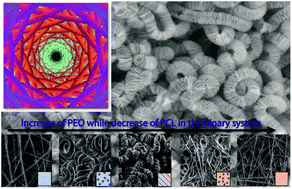Ultraporous interweaving electrospun microfibers from PCL–PEO binary blends and their inflammatory responses†
Abstract
Production of one dimensional nanomaterials with secondary morphology exhibiting unique functions is challenging. Here we report for the first time that a nanoscale immiscible polymer blend solution electrojet can assemble into ultraporous interweaving microfibers. This intriguingly novel morphology originated from a blend of polycaprolactone (PCL) and polyethylene oxide (PEO) in a DCM–DMF mixed solution when the ratio between each component reached a threshold and when the electrospinning parameters were delicately controlled. The morphology, crystallinity, surface chemistry and wettabilities were characterized to understand the mechanism of formation. The interplay of the two semi-crystalline polymers and the pair of solvents/non-solvents with the electrospinning processing parameters was found to be critical for the formation of the unique structure. Furthermore, the interesting combination of biocompatible, biodegradable PCL with protein-resistant PEO motivated us to assess its inflammation responses on the RAW 264.7 macrophage cell line. All fibers were found to be biocompatible with low inflammation potential upon incubation, while compared with pure PCL nanofibers; the unique interweaving microfibers induced a slightly higher inflammatory reaction.


 Please wait while we load your content...
Please wait while we load your content...